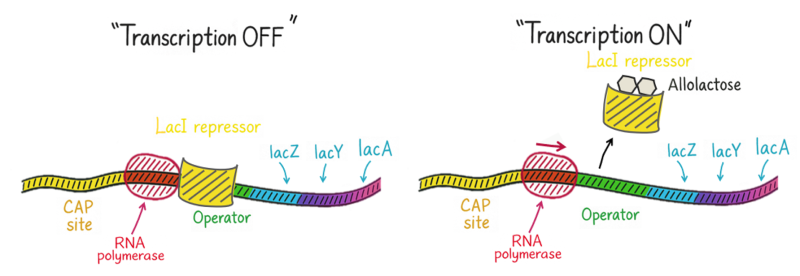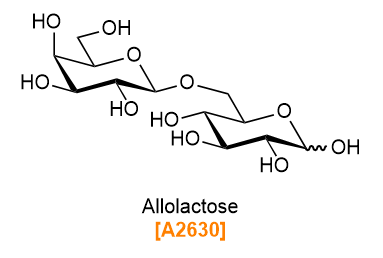Published TCIMAIL newest issue No.199
Maximum quantity allowed is 999
Allolactose and the lac Operon
The lac operon is a regulatory system in Escherichia coli that controls the expression of genes responsible for the breakdown and utilization of lactose. It is widely recognized as a classical model for gene expression regulation in prokaryotes and has played a pivotal role in foundational studies in molecular biology and synthetic biology.
The lac operon consists primarily of three structural genes (lacZ, lacY, and lacA) and regulatory sequences (including the promoter, operator, and CAP binding site) that control their expression. Among these, lacZ encodes β-galactosidase, an enzyme that hydrolyzes lactose into glucose and galactose.
Under normal conditions, the LacI repressor binds to the operator region, preventing the progression of RNA polymerase and thereby suppressing transcription of the structural genes. When lactose is taken up into the cell, it is converted by β-galactosidase into allolactose (Product No. A2630). Allolactose is a β(1→6)-linked isomer of lactose and functions as the natural inducer of the lac operon. When allolactose binds to the repressor, it induces a conformational change that causes the repressor to release from the operator, allowing transcription of lacZ, lacY, and lacA to proceed.

Applications of the lac Operon as a Gene Expression Control System
lacoperon, with its sophisticated inducible mechanism, continues to be utilized across various research and industrial fields as a tool for externally controlling the expression of target genes. In particular, the artificial regulatory system using IPTG (Isopropyl 1-Thio-β-D-galactopyranoside, Product No. I0328) has become widely adopted due to its ability to precisely regulate both the timing and level of gene expression.
IPTG is a synthetic inducer that structurally mimics allolactose. It exhibits high affinity for the lac repressor and excellent cell permeability, making it highly effective in controlled expression systems.1)
Allolactose as a Galacto-Oligosaccharide (GOS)
β-Galactosidase is an enzyme that hydrolyzes β-galactosidic linkages. In recent years, particular attention has been paid to β-galactosidases derived from lactic acid bacteria (LAB). These LAB-derived enzymes play a crucial role in the synthesis of galacto-oligosaccharides (GOS), a well-known class of prebiotics. It has been shown that the structural features of GOS—such as degree of polymerization, glycosidic linkage types, and the types of constituent monosaccharides—directly influence the fermentation patterns of probiotic gut bacteria, and the structural diversity of GOS is considered a key factor in their effects on the gut environment.2)
Traditionally, the prebiotic activity of GOS was attributed mainly to trisaccharides (GOS-3) and tetrasaccharides (GOS-4); however, recent studies have shown that disaccharides with β(1- 6) linkages, such as allolactose and galactobiose, also exhibit bifidogenic activity, promoting the growth of Bifidobacterium species.3)
As prebiotics, GOS are associated with a wide range of physiological benefits, including improved gut health, immune modulation, prevention of allergic diseases, and enhanced skin condition. However, the precise relationship between the individual GOS structures and their prebiotic effects remains largely unclear. This is due in part to the difficulty of isolating specific GOS structures as pure compounds from mixtures, and because most evaluations of prebiotic activity have been conducted using GOS mixtures.4)
We offer high-purity functional oligosaccharides, including allolactose, to support your research needs.
Related Products
- I0328
- Isopropyl 1-Thio-β-D-galactopyranoside
- L0008
- D-(+)-Lactose Monohydrate
- L0140
- Lactulose
- C0056
- D-(+)-Cellobiose
- M0050
- D-(+)-Melibiose Monohydrate
- C2795
- Cellotriose
- B3201
- 5-Bromo-4-chloro-3-indolyl β-D-Galactopyranoside [for Biochemical Research]
- B3470
- 5-Bromo-3-indolyl β-D-Galactopyranoside [for Biochemical Research]
- C2371
- 6-Chloro-3-indolyl β-D-Galactopyranoside [for Biochemical Research]
- N0418
- 2-Nitrophenyl β-D-Galactopyranoside [Substrate for β-D-Galactosidase]
- N0616
- 4-Nitrophenyl β-D-Galactopyranoside [Substrate for β-Galactosidase]
- M2134
- 4-Methylumbelliferyl β-D-Galactopyranoside
References
- 1) Analysis of inducers of the E.coli lac repressor system mammalian cells and whole animals
- 2) Screening, cloning and expression of β-galactosidase from lactic acid bacteria and semi-rational design for the improvement of transgalactosylation activity
- 3) Analysis of fermentation selectivity of purified galacto-oligosaccharides by in vitro human faecal fermentation
- 4) Novel Galacto-oligosaccharides from Lactose: Chemical Synthesis, Structural Characterization, and in Vitro Assessment of Prebiotic Activity




